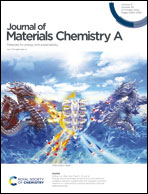A covalent organic framework for high-rate aqueous calcium-ion batteries†
Abstract
Abundant reserves of calcium in the earth's crust are expected to give calcium-ion batteries (CIBs) a price advantage. Nevertheless, the strong electrostatic interaction between calcium ions and battery host materials leads to low specific capacity and poor cycle performance. More reliable electrode materials need to be studied. Here, we report a covalent organic framework (COF) synthesized using 2,5-diaminohydroquinone dihydrochloride (Hq) and 1,3,5-triformylphloroglucinol (Tp) , HqTp, as an organic electrode anode material for Ca-ion storage in aqueous electrolytes. The COF provided high specific capacity (up to 119.5 mA h g−1 at 1 A g−1) and outstanding rate performance, maintaining 78.7 mA h g−1 even at an extremely high current of 50 A g−1. Mechanism studies using Fourier transform infrared spectroscopy and X-ray photoelectron spectroscopy revealed the reversible calcium insertion/extraction behavior with carbonyl as the active site. The remarkable rate performance largely benefits from the storage mechanism of the pseudocapacitance behavior. The co-insertion of protons and calcium ions and the in situ conversion of C–OH groups of HqTp to C![[double bond, length as m-dash]](https://www.rsc.org/images/entities/char_e001.gif) O groups was observed, which led to an activation. Finally, a full cell with HqTp and activated carbon as the active materials was assembled. The full cell provides an average working voltage of 0.6 V with a 73.7% capacity retention (0.0164% reduction per cycle) for 1600 cycles. This study demonstrates the potential for the COF material as the active host material for CIBs.
O groups was observed, which led to an activation. Finally, a full cell with HqTp and activated carbon as the active materials was assembled. The full cell provides an average working voltage of 0.6 V with a 73.7% capacity retention (0.0164% reduction per cycle) for 1600 cycles. This study demonstrates the potential for the COF material as the active host material for CIBs.



 Please wait while we load your content...
Please wait while we load your content...